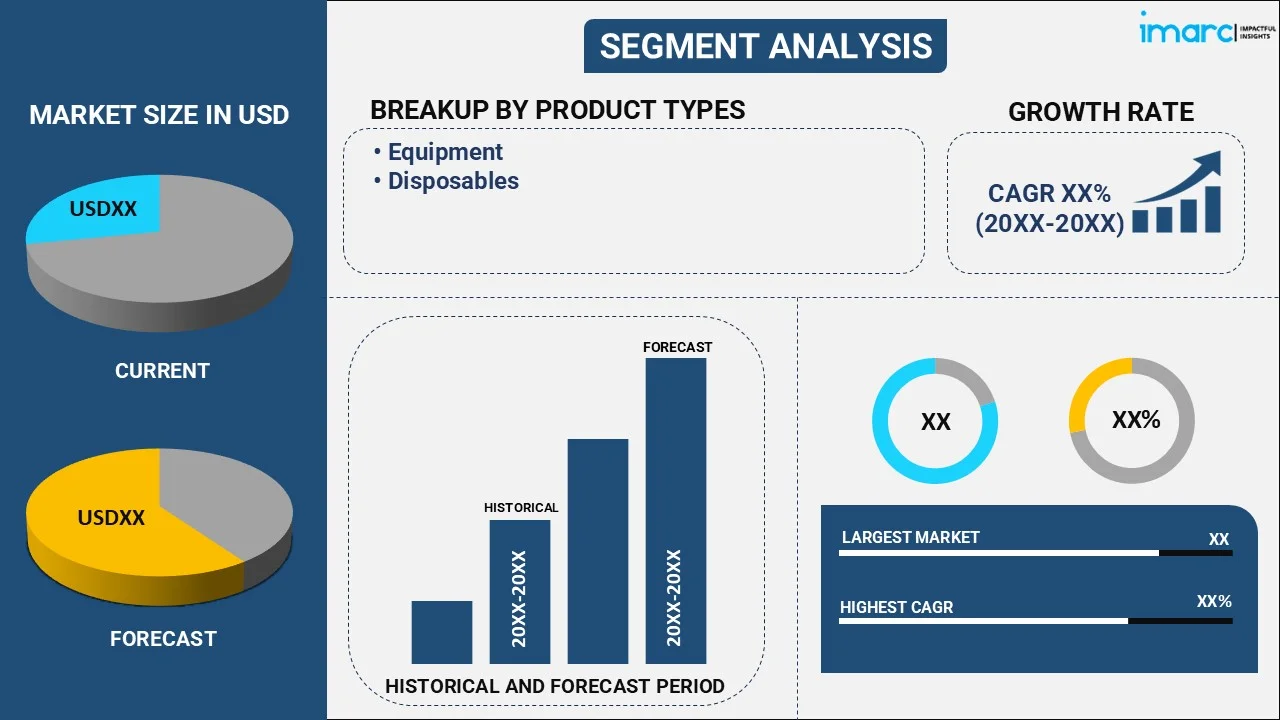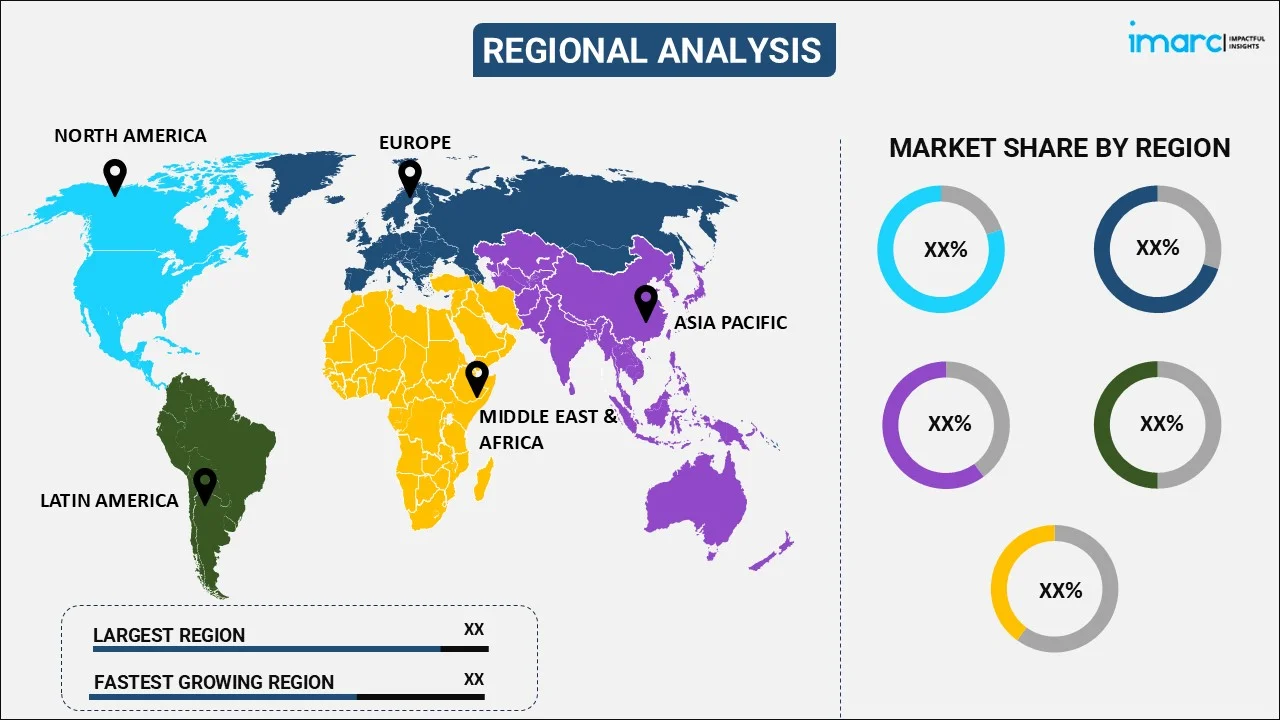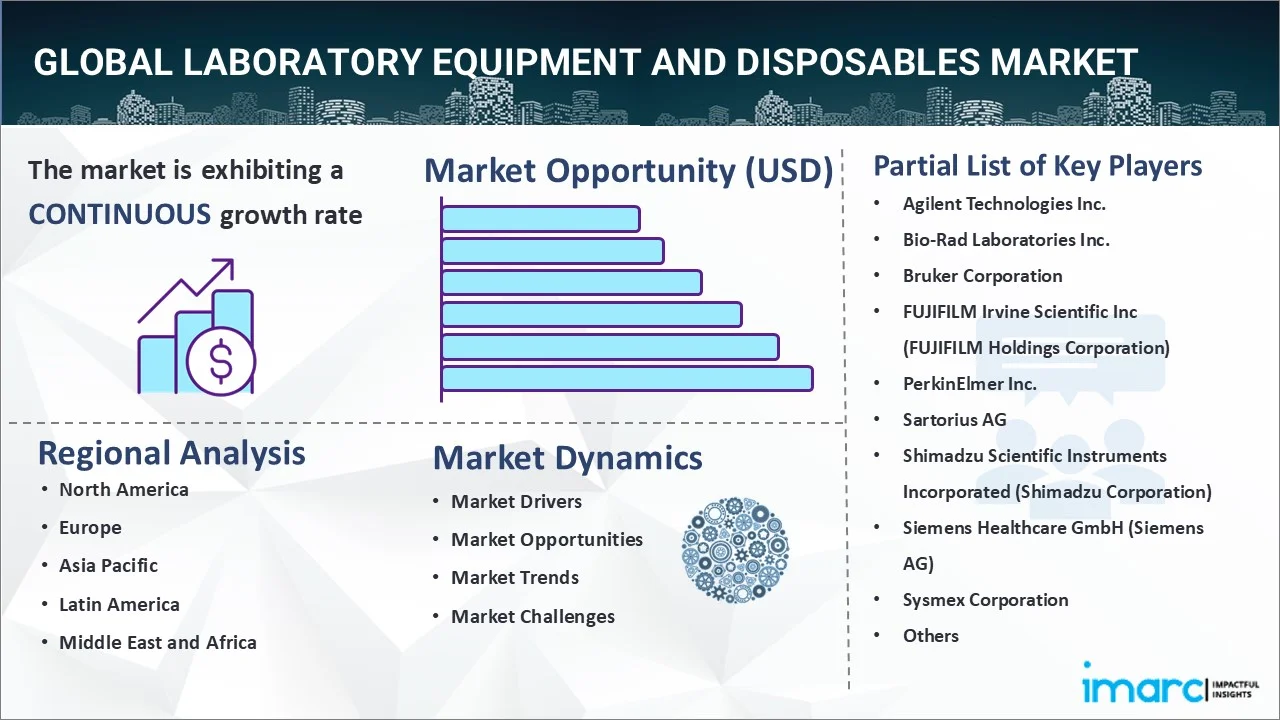
Laboratory Equipment and Disposables Market Report by Product Type (Equipment, Disposables), End Use (Hospitals, Laboratories, and Others), and Region 2025-2033
Laboratory Equipment and Disposables Market Overview:
The global laboratory equipment and disposables market size reached USD 40.5 Billion in 2024. Looking forward, IMARC Group expects the market to reach USD 74.8 Billion by 2033, exhibiting a growth rate (CAGR) of 6.69% during 2025-2033. There are various factors that are driving the market, which include the integration of advanced technologies, the implementation of several government initiatives, and the significant expansion in the healthcare sector including diagnostics and personalized medicine.
|
Report Attribute
|
Key Statistics
|
|---|---|
|
Base Year
|
2024
|
|
Forecast Years
|
2025-2033
|
|
Historical Years
|
2019-2024
|
|
Market Size in 2024
|
USD 40.5 Billion |
|
Market Forecast in 2033
|
USD 74.8 Billion |
| Market Growth Rate (2025-2033) | 6.69% |
Laboratory Equipment and Disposables Market Analysis:
- Major Market Drivers: One of the key market drivers include a rise in the prevalence of chronic diseases. Moreover, increasing awareness among individuals about infectious diseases is acting as a growth-inducing factor.
- Key Market Trends: The thriving healthcare sector and favorable government initiatives are some main trends in the market.
- Geographical Trends: As per the report, North America exhibits a clear dominance, accounting for the biggest market share due to the presence of numerous research institutions, universities, and pharmaceutical companies.
- Competitive Landscape: Various major market players in the laboratory equipment and disposables industry are Agilent Technologies Inc., Bio-Rad Laboratories Inc., Bruker Corporation, FUJIFILM Irvine Scientific Inc (FUJIFILM Holdings Corporation), PerkinElmer Inc., Sartorius AG, Shimadzu Scientific Instruments Incorporated (Shimadzu Corporation), Siemens Healthcare GmbH (Siemens AG), Sysmex Corporation, Thermo Fisher Scientific Inc., Waters Corporation, among many others.
- Challenges and Opportunities: The initial capital investment required for purchasing laboratory equipment and stringent regulatory compliance are key market challenges. Nonetheless, the expansion of point-of-care testing (POCT), along with the rising demand for personalized medicines, represent major opportunities in the market.
Laboratory Equipment and Disposables Market Trends:
Expansion in Healthcare Sector
The market is witnessing substantial growth in the healthcare sector, particularly in the field of diagnostics and personalized medicine. Several advancements in healthcare technology are transforming diagnostics with the advent of cutting-edge diagnostic tools such as high-throughput sequencers and advanced imaging systems, which enable quicker and more accurate disease detection, thereby influencing the market. These technologies rely on laboratory equipment and disposables, ranging from sample preparation kits to specialized diagnostic reagents, which is catalyzing the demand for these tools. Moreover, personalized medicine tailors treatments to individual patients based on their genetic makeup, lifestyle, and other factors, relying heavily on molecular diagnostics, genetic testing, and biomarker analysis, thereby increasing laboratory equipment and disposables demand. Besides this, the rising adoption of laboratory equipment and disposables in the healthcare systems to process a large volume of tests efficiently and shift toward automation and high-throughput testing is bolstering the market growth. On 13 January 2023, Siemens Healthineers launched a Center of Excellence for Immunoassay Instrument Research and Development (R&D) in Swords, Ireland. The new center will focus on unlocking breakthrough innovations in laboratory instruments used to detect infectious diseases, cancer, and blood disorders. The existing manufacturing and engineering site, which supplies medical diagnostic equipment globally, will receive a multi-million-euro investment from Siemens Healthineers.
Emerging Technological Advancements
The market is witnessing a transformative wave of emerging technological advancements in scientific research and experimentation. These innovations can enhance precision, efficiency, and data accuracy, which is supporting the laboratory equipment and disposables market growth. In addition, there is a rise in the integration of automation and robotics into laboratory workflows. Automated systems can perform repetitive tasks with precision, thereby reducing human error and increasing throughput. This also accelerates research and minimizes the risk of contamination, particularly in sensitive experiments. Besides this, the introduction of microfluidic devices allows researchers to conduct experiments on a much smaller scale, conserving valuable samples and reagents that offer greater control over experimental parameters and can be used in applications ranging from drug discovery to deoxyribonucleic acid (DNA) analysis. Additionally, the integration of data analytics and artificial intelligence (AI) analyzes vast datasets generated by laboratory equipment and identifies patterns and insights. On 1 April 2024, Agilent Technologies Inc. introduced its advanced dilution system, the ADS 2, a new automation workflow solution that will assist in increasing productivity, lowering cost of ownership, and improving the overall efficiency within the laboratory. The Agilent ADS 2 is an intelligent autodilutor designed to enhance laboratory workflows.
Government Initiatives
Governing agencies of various countries are undertaking several initiatives, ranging from promoting scientific research to ensuring the quality and safety of healthcare services. They are implementing regulatory initiatives to ensure the safety and quality of equipment. These regulations include product quality, performance, and safety standards. Along with this, government-sponsored innovation programs, tax incentives, and research grants encourage the development of new laboratory technologies and solutions resulting in the introduction of novel products in the market, attracting the attention of research professionals and healthcare providers. Moreover, governing authorities are allocating budgets to support research and development (R&D) activities in various fields, including healthcare and life sciences. This funding often includes grants and subsidies that enable research institutions to acquire advanced laboratory equipment and disposables. For instance, on 27 July 2023, the governing agencies in Canada and JDRF Canada jointly invested US$ 33 Million in 12 research projects that will work to prevent, detect, manage, and treat diabetes. Four research teams will work on precision medicine in type 1 diabetes to tailor diabetes care to each patient’s specific needs and investigate the diversity within beta cell populations.
Laboratory Equipment and Disposables Market Segmentation:
IMARC Group provides an analysis of the key trends in each segment of the laboratory equipment and disposables market, along with forecast at the global, regional, and country levels for 2025-2033. Our report has categorized the market based on product type and end use.
Breakup by Product Type:

- Equipment
- Incubators
- Laminar Flow Hood
- Micro Manipulation Systems
- Centrifuges
- Lab Air Filtration System
- Scopes
- Sonicators and Homogenizers
- Autoclaves and Sterilizers
- Spectrophotometers and Microarray Equipment
- Others
- Disposables
- Pipettes
- Tips
- Tubes
- Cuvettes
- Dishes
- Gloves
- Masks
- Cell Imaging Consumables
- Cell Culture Consumables
Equipment accounts for the majority of the market share
The report has provided a detailed breakup and analysis of the market based on the product type. This includes equipment (incubators, laminar flow hood, micro manipulation systems, centrifuges, lab air filtration system, scopes, sonicators and homogenizers, autoclaves and sterilizers, spectrophotometers and microarray equipment, and others) and disposables (pipettes, tips, tubes, cuvettes, dishes, gloves, masks, cell imaging consumables, and cell culture consumables). According to the report, equipment represented the largest segment.
Incubators and other related equipment help to maintain precise ambient conditions and temperatures for investigations involving cell growth and microbiology. Additionally, micro manipulation systems enable precise procedures at the microscale, enabling genetic engineering and cell research, and laminar flow hoods provide a sterile workspace by directing filtered air to prevent contamination, thus offering a positive laboratory equipment and disposables market outlook. Additionally, lab air filtration systems guarantee a sterile and controlled laboratory environment, and centrifuges are essential for separating components in biological samples.
Breakup by End Use:
- Hospitals
- Laboratories
- Others
Hospitals hold the largest share of the industry
A detailed breakup and analysis of the market based on the end use have also been provided in the report. This includes hospitals, laboratories, and others. According to the report, hospitals accounted for the largest market share.
Hospitals are the primary providers of comprehensive medical services. They require an extensive array of laboratory equipment for diagnostic purposes including blood analyzers, centrifuges, and diagnostic imaging systems like magnetic resonance imaging (MRI) and computed tomography (CT) scanners that aid in the accurate diagnosis of diseases and enable timely treatment. Moreover, hospitals have a constant need for disposable items such as syringes, test tubes, and medical gloves, thus representing another major growth-inducing factor. These disposables are essential for maintaining strict hygiene standards and preventing the spread of infections within a hospital environment. Along with this, the rising focus on infection control is leading to the demand for disposables in healthcare settings.
Breakup by Region:

- North America
- United States
- Canada
- Asia-Pacific
- China
- Japan
- India
- South Korea
- Australia
- Indonesia
- Others
- Europe
- Germany
- France
- United Kingdom
- Italy
- Spain
- Russia
- Others
- Latin America
- Brazil
- Mexico
- Others
- Middle East and Africa
North America leads the market, accounting for the largest laboratory equipment and disposables market share
The report has also provided a comprehensive analysis of all the major regional markets, which include North America (the United States and Canada); Asia Pacific (China, Japan, India, South Korea, Australia, Indonesia, and others); Europe (Germany, France, the United Kingdom, Italy, Spain, Russia, and others); Latin America (Brazil, Mexico, and others); and the Middle East and Africa. According to the report, North America represents the largest regional market for laboratory equipment and disposables.
The presence of world-renowned research institutions, universities, and pharmaceutical companies in the North America region is impelling the market growth. These organizations rely on advanced laboratory equipment and disposables to conduct cutting-edge research, drive innovation, and develop new products. Moreover, several technological advancements in the field of laboratory equipment are introduced to create advanced, user-friendly, and precise laboratory instruments to meet local demands and attract international buyers. Apart from this, favorable government initiatives in the region are bolstering the market growth. For example, on 7 March 2023, Washington University School of Medicine in St. Louis positioned to NO.2 in nation due to National Institutes of Health (NIH) research funding. This ranking reflects the school’s commitment to cutting-edge research and positions it as a key player in shaping the future of medicine.
Competitive Landscape:
- The market research report has also provided a comprehensive analysis of the competitive landscape in the market. Detailed profiles of all major companies have also been provided. Some of the major market players in the laboratory equipment and disposables industry include Agilent Technologies Inc., Bio-Rad Laboratories Inc., Bruker Corporation, FUJIFILM Irvine Scientific Inc (FUJIFILM Holdings Corporation), PerkinElmer Inc., Sartorius AG, Shimadzu Scientific Instruments Incorporated (Shimadzu Corporation), Siemens Healthcare GmbH (Siemens AG), Sysmex Corporation, Thermo Fisher Scientific Inc., and Waters Corporation.
(Please note that this is only a partial list of the key players, and the complete list is provided in the report.)
- Key players in the market are actively taking strategic measures to strengthen their positions in the industry. These actions are a response to the competitive landscape and the evolving needs of end users. Companies are investing in R&D to introduce innovative and technologically advanced products including the development of precise and efficient laboratory equipment, disposables with enhanced features, and automation solutions that streamline laboratory processes to increase their laboratory equipment and disposables market revenue. Moreover, companies are forming strategic partnerships and collaborations with research institutions, universities, and other industry players, which facilitate knowledge exchange, access to new technologies, and the development of customized solutions. Apart from this, market players are expanding their presence globally by establishing subsidiaries or acquiring local companies in emerging markets to serve individuals across the globe. On 4 April 2024, Shimadzu Medical Systems USA (SMS), a medical division of Shimadzu Precision instruments, Inc., acquired California X-ray Imaging Services, Inc. (CIS) to further expand its Healthcare Business in North America.
Laboratory Equipment and Disposables Market Recent Developments:
- 9 February 2024: Bruker Corporation acquired Nanophoton Corporation, a pioneer focused on advanced research Raman microscopy systems. Nanophoton offers a broad portfolio of advanced Raman microscopes, serving academic and industrial research individuals, primarily in Japan. This acquisition fills a gap in Bruker’s molecular microscopy portfolio, and it is looking forward for offering fast, flexible, and sensitive Nanophoton Raman microscopy systems worldwide for R&D in the life sciences, biopharma, advanced materials, semiconductors, and polymers.
- 4 December 2023: PerkinElmer, a leading global analytical services and solutions provider, announced that it acquired Covaris, a leading developer of solutions to empower life science innovations. The merger will accelerate Covaris’ growth potential and expand PerkinElmer’s existing life sciences portfolio into the high-growth diagnostics end market. In addition, both companies are majority owned by New Mountain Capital.
Laboratory Equipment and Disposables Market Report Scope:
| Report Features | Details |
|---|---|
| Base Year of the Analysis | 2024 |
| Historical Period | 2019-2024 |
| Forecast Period | 2025-2033 |
| Units | Billion USD |
| Scope of the Report | Exploration of Historical Trends and Market Outlook, Industry Catalysts and Challenges, Segment-Wise Historical and Future Market Assessment:
|
| Product Types Covered |
|
| End Uses Covered | Hospitals, Laboratories, Others |
| Regions Covered | Asia Pacific, Europe, North America, Latin America, Middle East and Africa |
| Countries Covered | United States, Canada, Germany, France, United Kingdom, Italy, Spain, Russia, China, Japan, India, South Korea, Australia, Indonesia, Brazil, Mexico |
| Companies Covered | Agilent Technologies Inc., Bio-Rad Laboratories Inc., Bruker Corporation, FUJIFILM Irvine Scientific Inc (FUJIFILM Holdings Corporation), PerkinElmer Inc., Sartorius AG, Shimadzu Scientific Instruments Incorporated (Shimadzu Corporation), Siemens Healthcare GmbH (Siemens AG), Sysmex Corporation, Thermo Fisher Scientific Inc., Waters Corporation, etc. |
| Customization Scope | 10% Free Customization |
| Post-Sale Analyst Support | 10-12 Weeks |
| Delivery Format | PDF and Excel through Email (We can also provide the editable version of the report in PPT/Word format on special request) |
Key Benefits for Stakeholders:
- IMARC’s industry report offers a comprehensive quantitative analysis of various market segments, historical and current market trends, market forecasts, and dynamics of the market from 2019-2033.
- The research report provides the latest information on the market drivers, challenges, and laboratory equipment and disposables market recent opportunities.
- The study maps the leading, as well as the fastest-growing, regional markets. It further enables stakeholders to identify the key country-level markets within each region.
- Porter's five forces analysis assists stakeholders in assessing the impact of new entrants, competitive rivalry, supplier power, buyer power, and the threat of substitution. It helps stakeholders to analyze the level of competition within the laboratory equipment and disposables industry and its attractiveness.
- The competitive landscape allows stakeholders to understand their competitive environment and provides insight into the current positions of key laboratory equipment and disposables market companies.
Key Questions Answered in This Report
The global laboratory equipment and disposables market was valued at USD 40.5 Billion in 2024.
We expect the global laboratory equipment and disposables market to exhibit a CAGR of 6.69% during 2025-2033.
The growing adoption of laboratory equipment and disposables to store, collect, and process specimens, as they assist in improving the efficiency of testing and avoiding laboratory mishaps, is primarily driving the global laboratory equipment and disposables market.
The sudden outbreak of the COVID-19 pandemic has led to the increasing demand for laboratory equipment and disposables, such as tubes, gloves, masks, etc., to prevent the coronavirus infection contaminating the laboratories.
Based on the product type, the global laboratory equipment and disposables market has been segregated into equipment and disposables, where equipment currently exhibits a clear dominance in the market.
Based on the end use, the global laboratory equipment and disposables market can be bifurcated into hospitals, laboratories, and others. Currently, hospitals account for the majority of the global market share.
On a regional level, the market has been classified into North America, Asia-Pacific, Europe, Latin America, and Middle East and Africa, where North America currently dominates the global market.
Some of the major players in the global laboratory equipment and disposables market include Agilent Technologies Inc., Bio-Rad Laboratories Inc., Bruker Corporation, FUJIFILM Irvine Scientific Inc (FUJIFILM Holdings Corporation), PerkinElmer Inc., Sartorius AG, Shimadzu Scientific Instruments Incorporated (Shimadzu Corporation), Siemens Healthcare GmbH (Siemens AG), Sysmex Corporation, Thermo Fisher Scientific Inc., and Waters Corporation.
Need more help?
- Speak to our experienced analysts for insights on the current market scenarios.
- Include additional segments and countries to customize the report as per your requirement.
- Gain an unparalleled competitive advantage in your domain by understanding how to utilize the report and positively impacting your operations and revenue.
- For further assistance, please connect with our analysts.


 Inquire Before Buying
Inquire Before Buying
 Speak to an Analyst
Speak to an Analyst
 Request Brochure
Request Brochure
 Request Customization
Request Customization



.webp)




.webp)












